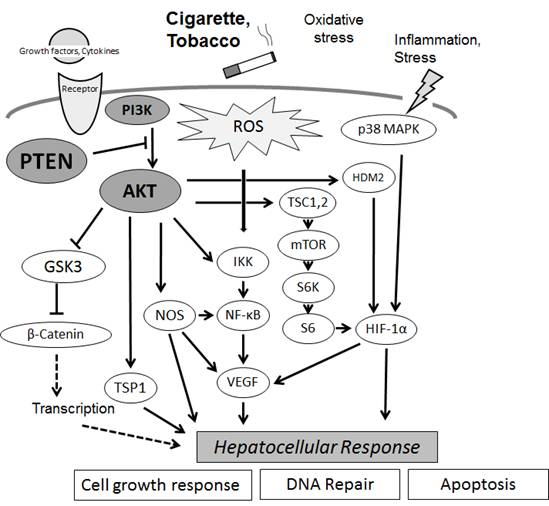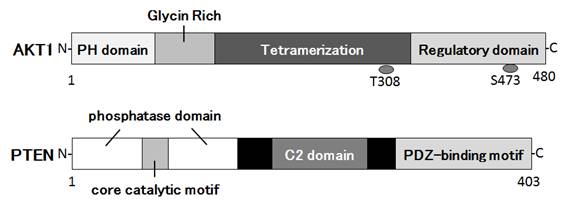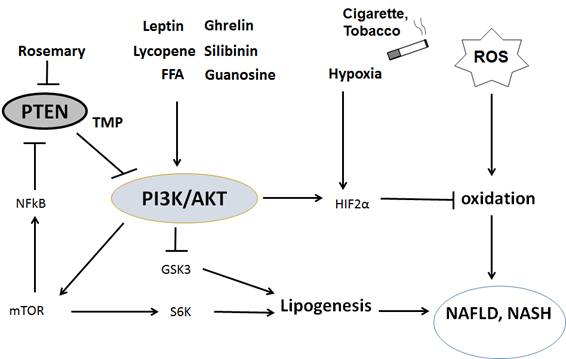Abbreviations:
|
ECM: extracellular matrix
|
FFA: free fatty acids
|
|
GLUT4: glucose transporter 4
|
HDL: high-density lipoprotein
|
|
HO-1: heme oxygenase-1
|
HSC: hepatic stellate cell
|
|
LDL: low density lipoprotein
|
mTOR:mammalian target of rapamycin
|
|
NF-κB: nuclear factor κB
|
NAFLD: Nonalcoholic fatty liver disease
|
|
NASH: nonalcoholic steato-hepatitis
|
PDK1: phosphoinositide-dependent kinase 1
|
|
PH: plekstrin homology
|
PIP2: phosphatidylinositol 4,5-bisphosphate
|
|
PIP3: phosphatidylinositol 3,4,5-triphosphate
|
PI3K: phosphatidylinositol-3 kinase
|
|
PTEN: phosphatase and tensin homologue deleted on chromosome 10
|
|
|
ROS: reactiveoxygen species
|
|
|
TMP: heterocyclic nitrogen compound, 2,3,5,6-tetramethylpyrazine
|
|
|
TNF-a: tumor necrosis factor-alpha
|
TSC1: tuberous sclerosis complex 1
|
|
VEGF: vascular endothelial growth factor
|
|
1. Introduction
Nonalcoholic fatty liver diseases (NAFLD) signify a hepatic facet of metabolic syndrome, which is the collective broad-spectrum term for non-infectious chronic liver disease [1,2]. To date, however, the precise molecular pathogenesis of NAFLD is still unclear. Disease progression in NAFLD may occur amidst a complex background of endocrine and metabolic derangements. These imbalances promote persistent subclinical activation of the innate immune system, and when coupled together with genetic and environmental factors, a worldwide health problem arises. Hepatocellular damage causes the activation of regenerative pathways as well as the proliferation of hepatic stellate cells (HSCs) [3]. NAFLD ranges from nonalcoholic fatty liver to nonalcoholic steato-hepatitis (NASH), which often precedes liver fibrosis, cirrhosis, and hepatocellular carcinoma. The hepatic inflammatory state of fatty liver is characterized by increased free fatty acids (FFA), which cause lipotoxicity and impair endothelium-dependent vasodilation, as well as lead to increased oxidative stress [4]. Inflammation and fibrogenesis are chief targets of NAFLD research. NAFLD is associated with obesity, type 2-diabetes, and metabolic syndrome [5]. In addition, reactive oxygen species (ROS), endotoxins, and inflammatory cytokines mayresult in disease development [6]. It is well known that several stressors, such as cigarette smoke, pollutants, and hypercholesterolemia are all risk factors forliver diseases [7,8]. In particular, cigarette smoking remains a health threat for both smokers and nonsmokers. Secondhand smoke is more toxic than directly inhaled smoke. Recently, a new threat has been discovered, third hand smoke, which is the accumulation of smoke on surfaces that ages over time, becoming gradually much more toxic [9]. However, the clinical relevance of suchfindings are controversial. A study has shown no relationship between smokingand NAFLD [10]. In addition, it is also documented that NAFLD is not affected by smoking [11].In contrast, it has been shown that passive smoking and heavy, active smoking are associated with prevalent NAFLD in middle-aged and elderly people [12].There is also a report indicating that the combination of current smoking and harboring high-risk glutathione S-transferase polymorphisms is interactively associated with the risk of NAFLD [13].
Inflammation is believed to be the dominant driver of NAFLD, and may cause the disease’s progression to fibrosis and subsequent cirrhosis [14]. Because phosphatidylinositol-3 kinase (PI3K) and serine/threonine protein kinase AKT (also known as protein kinase B) seem to activate various cells through regulation of the key inflammatory cytokines [15,16], changes in the PI3K/AKT signaling pathway may contribute to therapeutic effects in NAFLD. In addition, the physiological function of PTEN (phosphatase and tensin homologue) is to dephosphorylate the second messengers generated by the activation of PI3K, thereby down-regulating the signaling downstream of PI3K [17]. Therefore, it has been suggested that PTEN is potentially involved in the development of the NAFLD and NASH [18]. Here, we provide an overview of research on the characterization of the regulation of PI3K/AKT/PTEN signaling (Figure 1) at the viewpoint of the pathogenesis of NAFLD and NASH. We will also interpret the current literature in an attempt to expand our understanding of the environmental and genetic causes of inflammation due to cigarette smokeand its effects onNAFLD and NASH. Intervention and therapy that alter or disrupt these mechanisms may serve to reduce the risk of the development of the disease, leading to better efficacy of new therapeutic approaches.
2. Oxidative stress is related to the pathogenesis of NAFLD and NASH
Induction of ROS leads hepatocytes into a state of oxidative stress which, when coupled with cellular apoptosis, is believed to play an important role in pathogenesis of NAFLD and NASH [19,20]. ROS are produced during mitochondrial oxidative metabolism, as well as during cellular response to inflammatory cytokines and/or infectious invasions [21]. Oxidative stress arises from the imbalance between excess ROSand the capability of the cell to support effective antioxidant responses. The ROS interact with critical molecules to initiate signaling in a variety of cellular processes, such as proliferation and survival via various signaling molecules including PI3K, MAP kinases, and protein tyrosine phosphatases [22,23]. For example, oxidative stress can activate a series of stress pathways involving a family of serine/threonine kinases including AKT [24]. Therefore, oxidative stress may result in various disease states such as diabetes, atherosclerosis, aging, and cancer. NAFLD isthoroughly linked to atherosclerosis due to their common origin.Long-term exposure to cigarette smoke increasesROS levels and interfereswith DNA repair capacity, eventually inducing oxidative DNA damage [25], which actually worsens the severity of NAFLD in obese rats [26]. Additionally, available evidence supports a prospective association between air pollutants and an increased risk for type 2 diabetes [27]. In particular, passive smoking is a risk factor of type 2 diabetes even in those who were not themselves active smokers [28]. NAFLD is highly prevalent withtype 2 diabetes, likely reflecting the frequent occurrence of obesity and insulin resistance in type 2 diabetes [29].
Epidemiologic studies have shown the interactive effect of heavy cigarette smoking on the development of hepatocellular carcinoma. Chronic hepatocyte death can trigger excessive compensatory proliferation, which results in the future formation of tumors in theliver. Benzopyrene, an environmental agent found in cigarettesmoke, causesoxidative stress and acts as an agent which triggers the death of liver cells [30]. Cigarette smoke also stimulates accumulation of fat in hepatocytes [31]. Smoking is linked to the high levels of chemical toxins, even long after vigorous smoking has occurred. Third-hand smoke has been described as the residual smoke pollution that remains after a cigarette is extinguished [32]. This residual smoke reacts with nitrous acid to form specific nitrosamines, which are very carcinogenic [33]. In addition, the blood of the animals exposed to third-hand smoke shows evocatively elevated levels of triglycerides and low density lipoprotein (LDL), whereas high-density lipoprotein (HDL) is considerably decreased [34]. Lipid elevation of more than 5% above normal levels indicates that steatosis has progressed to NAFLD [35]. The hallmark of NAFLD is defined by the accumulation of triglycerides in more than 5% of hepatocytes.
3. Smoking compounds modulates the PI3K/AKT/PTEN pathway
Exposure to the carcinogens in cigarette smoke is known to damage DNA by causing genetic mutations and epigenetic alterations [36]. The post-translational modifications of histones are also associated with carcinogenesis. Recent studies have suggested that continuous tobacco carcinogen exposure even enhances the selection of the epigenetically altered cells [36]. However, the relationship between carcinogenicity and histone modification has not yet been well clarified. Chemicals in cigarette smoke, such as aldehydes, may phosphorylate histone H3 via the PI3K/AKT pathway, which differs from the DNA damage response, resulting in tumor promotion [37]. In addition, long exposure of cells to smoke compoundsinhibits apoptosis and autophagy, revealing a central role for the PI3K/AKT pathway in mediating the crucial carcinogenic effects of smoke compounds [38]. PTEN is an important regulator of cell cycle progression and cellular survival via the PI3K/AKT signaling pathway [39]. In addition, prolonged cigarette smoke exposure alters mitochondrial structure and function [40]. There is growing evidence that mitochondrial oxidative stress plays a critical role in the pathogenesis of NAFLD. Hydrogen sulfide may exert antioxidant effects in rats exposed to smoke via PI3K/AKT/PTEN dependent activation [41]. Mitochondrial network morphology involves ROS and PI3K/AKT, as well as transcriptional regulation via several factors, such as nuclear factor κB (NF-κB) [42]. Altered mitochondrial proteins also have the potential to influence parameters such as ROS production, cell proliferation, and apoptosis, all of which are relevant to NAFLD. The prevalence of cigarette smoking is increased among obese subjects, who are susceptible to develop NAFLD. Importantly, cigarette smoking increases the histological severity of NAFLD in obese rats [26]. In addition, smoking also increases the degree of oxidative stress and hepatocellular apoptosis in obese rats by regulating AKT phosphorylation [26].
4. Characterization of the PI3K/AKT/PTEN pathway
The PI3K/AKT pathway plays an important role in regulating cellular metabolism, growth, and survival [43,44]. As the active form of PI3K is an oncogene, mutations and amplifications of PI3K are frequently found in various kinds of human cancers [45]. The phospholipid messengers generated by PI3K provide a shared mechanism across multiple steps during intracellular signal transduction. Activation of PI3Kmay then result in the inhibition of pro-inflammatory events, such as expression of IL-12, type I interferon, and TNF-a (tumor necrosis factor-alpha) [46]. In addition, PI3K and downstream mTOR (mammalian target of rapamycin) seem to up-regulate anti-inflammatory cytokines [47]. For example, inhibition of VEGF (vascular endothelial growth factor) receptor activity augments cigarette smoke-induced oxidative stress and inflammatory responses [48]. PI3K/AKT signaling may control angiogenesis through several downstream targets, such as NOS (nitric oxide synthase) and GSK3β (glycogen synthase kinase 3 beta), which commonly up-regulate HIF-1α (hypoxia-inducible factor 1) expression, which in turn induces VEGF transcriptional activation. Inhibition of GSK3β can up-regulate HIF-1α expression and increases β-catenin activity. Hypoxia induces HIF-1α production through the increase of its presence and induces VEGF expression in a HIF-1α-dependent manner [49]. Furthermore, in the presence of abdominal obesity, VEGF concentrationis increased [50]. Obesity and insulin resistance are also associated with systemic markers of inflammation in NASH [51]. Inhibition of the mTOR pathway effectively attenuates inflammation in animal models [52]. AKT functions as a major downstream target of PI3K. A product of PI3K, phosphatidylinositol 3,4,5-triphosphate (PIP3), binds to AKT and leads to membrane staffing of AKT, which also binds to phosphoinositide-dependent kinase 1 (PDK1) via its plekstrin homology (PH) domains, then PDK1 phosphorylates AKT (Thr 308 in AKT1; human AKT has three isoforms: AKT1, AKT2, and AKT3 [53].) in the AKT kinase domain. For full activation of AKT, phosphorylation within the carboxyl-terminal regulatory domain (Ser 473 in AKT1) of AKT by phosphoinositide-dependent kinase 2 (PDK2) is required [54]. Schematic structure of the predicted AKT1 protein is shown in Figure 2. Once activated, AKT is located inboth the cytoplasm and nucleus, where it phosphorylates, activates, or inhibits many downstream targets, thereby regulating several cellular functions (Figure 1).
PTEN functions as a dually-specific phosphatase that antagonizes PI3K activity through converting PIP3 into phosphatidylinositol 4,5-bisphosphate (PIP2), which has lipid phosphatase action, as well as protein phosphatase action [55]. The schematic structure of the predicted PTEN protein has also been shown in Figure 2. PTEN protein contains N-terminal phosphatase, and C-terminal C2, and PDZ (PSD-95, DLG1, and ZO-1) binding domains. The PTEN CX5R (S/T) motif surrounds the catalytic site with three basic residues within the functional site, which are critical for PTEN lipid phosphatase activity. The structure provides PTEN with its preference for acidic phospholipid substrates including phosphatidylinositol phosphates, such as PIP3. In addition, the C-terminus of PTEN is comprised of two PEST (proline, glutamic acid, serine, and threonine) sequences involved in certain protein degradation [56]. Interestingly, rosemary extract represses PTEN expression in K562 leukemic culture cells [57]. Usually, p53, peroxisome proliferator activated receptor-γ (PPAR-γ), and activating transcription factor 2 can transcriptionally upregulate PTEN expression, while Jun, transforming growth factor-β (TGF-β), and NF-κB negatively regulate PTEN expression.PTEN activity could also be regulated by post-translational modifications, including oxidation, phosphorylation, and acetylation [58]. The lack of expression of liver-specific PTEN may be associated with hepatic inflammation, steatosis, and fibrosis. Actually, PTEN-deficient mice have been shown to have histological and biochemical evidences of NASH [59]. In addition, hypoxia quickens the changes that have been observed in PTEN-deficient mice developing NASH [60].
5. PI3K/AKT/PTEN signaling modulators involved in NAFLD
The molecular mechanisms underlying how the conversion from modest fatty liver to NASH is made are not well understood. However, accumulating evidence indicates that deregulation of the PI3K/AKT pathway in hepatocytes is a collective event associated with metabolic dysfunctions, including NAFLD. Animals with NAFLD show pathological changes, including inflammation foci and apoptotic cells in the liver [61]. HSCs have been shown to produce leptin when they become activated during hepatic fibrogenesis [62]. Leptin augments the proliferation of HSCs by enhancing downstream intracellular signaling pathways via the PI3K/AKT pathway [63]. Leptin is one of the key regulators for inflammation and the progression of fibrosis in various chronic liver diseases, including NASH [62,64]. Interestingly, treatment with ghrelin also improves those liver injury accompanied with a restoration of PI3K/AKT pathways [65]. Ghrelin treatment alone did not influence the healthy rat liver.Ghrelin and leptin are hormones which regulate appetite and energy balance; while ghrelin increases food intake and causes a positive energy balance, leptin decreases food intake and enhances a negative energy balance. Cigarettesmoke limits food intake and body weight increase and plasma levels of ghrelin and leptin may change to compensate for the negative energy balance created by cigarettesmoke [66].
The heterocyclic nitrogen compound, 2,3,5,6-tetramethylpyrazine (TMP), naturally present in tobacco and also added to tobacco as a flavor ingredient, blocks the downstream PI3K/AKT pathway. TMP inhibits HSC activation and extracellular matrix (ECM) production by inhibiting the PI3K/AKT pathway [67]. Guanosine can afford protection against mitochondrial oxidative stress through PI3K/AKT signaling and by induction of the antioxidant enzyme heme oxygenase-1 (HO-1) [68]. The protective effects of this pathway may be linked to the action of HO-1.Unusual fatty acid accumulation has a possible role in promoting in vivohepato-tumorigenesis under constitutive activation of the PI3K pathway [69]. Impairment offatty acid oxidation and the accumulation of lipids characterize lipotoxicity. Experimental studies have shown the toxic effects of cigarettesmoke on energy metabolism [70]. Silibinin is a well-studied hepato-protective agent against a spectrum of liver diseases. Silibinin treatment significantly ameliorates the pathological features of liver diseases partly through restoring the PI3K/AKT pathway. Accordingly, specific blockers of PI3K abolish the positive effects of silibinin on cellular steatosis. Silibinin may also improve steatosis and insulin resistance partly through regulation of the PI3K/AKT pathway [71]. Furthermore, silibinin has the potential to inhibit the induction of DNA damage mediated by chlorination, thus there isa possible application of reducing the DNA damage associated with inflammation and cigarette-smoke toxicity [72]. Likewise, lycopene may also exert protective effects against the risk of cigarette smoke [73].
Molecular NAFLD studies support a key role for PTEN in the development of steatosis and fibrosis. However, deletion of PTEN paradoxically causes NAFLD and hepatocellular cancer [74]. The mechanism for this paradox is yet to be clarified. In PTEN-deficient mice, there is increased triglyceride synthesis and storage in hepatocytes, due to the up-regulation of PI3K/AKT activity. As a consequence of the lack of PTEN activity, there may be increased hepatocyte fatty acid uptake and increased fatty acid synthesis [75]. In addition, alterations of PTEN expression and activity in hepatocytes are common and recurrent molecular events associated with liver disorders of various etiologies, such as obesity, the metabolic syndrome, hepatitis B and hepatitis C viral infections, and frequent alcohol consumption occur. A critical role for PTEN in hepatic insulin sensitivity and the development of steatohepatitis and fibrosis has been supported. PTEN mutations, deletion, or low PTEN expression have also been associated with diverse liver malignancies, suggesting a critical role for PTEN in hepatic cancers [76]. In contrast, overexpression of PTEN has been shown to have inhibitory effects on insulin signaling, including decreased AKT activity and GLUT4 (glucose transporter 4) translocation to the hepatic cell membrane, showing PTEN’s contribution to insulin resistance and NAFLD progression [77,78].
6. Conclusion
Occasionally, it would be difficult to avoid second and third handsmoke exposure. Given the development of smoking as a concern, far less research has focused on the perceived harm of smokeexposure. It is important to exploit the potential benefits of agents in NAFLD and/or optimal treatment, as they could become effective intervention targets (Figure 3). NAFLD is a multifactorial disease predominantly regulated by the interaction of genetic predisposition and environmental factors. It is accepted that the molecular mechanisms involved in the development and progression of NAFLD are similar to those leading to metabolic syndrome. In fact, the dysregulation of lipid metabolism, insulin signaling, the inflammatory response, and the immune response have important role in the onset and result of NAFLD. There may be common signaling pathways between inflammation and NAFLD, including the PI3K/AKT pathway. It is possible that inhibition of the signaling in specific hepatic cell populations could be associated with distinct therapeutic outcomes; therefore, the molecular mechanism contributing to the diseases are the subject of considerable investigation [79]. A betterunderstanding of the precise intracellular mechanisms downstream of PI3K/AKT/PTEN signaling and their changes in NAFLD could provide novel insights into the development of new therapeutic approaches having greater efficacy against NAFLD.
Acknowledgments
This work was supported by JSPS KAKENHI Grant Number 25560050, 26-12035, 24240098.
Conflicts of Interest
The authors declare that they have no competing interests.










 DownLoad:
DownLoad: 







